Milk paint or chalk based paint? That is the question.
Which one is best?
I’ve used both now, so I’m going to weigh on on the debate.
Let’s talk about milk paint first. It comes in a powder and you mix it up as needed. Here is what it looks like.
[shopify embed_type=”product” shop=”cedarhillfarmhouse.myshopify.com” product_handle=”amy-howard-at-home-toscana-paint-noir” show=”all”]
You can use it on many surfaces too. It actually has a more subtle look if you are going to distress it. It can be distressed with water. It needs a wax coating to protect just like chalk based paint. This clock has a base coat of chalk based paint, but has a top coat of milk paint.
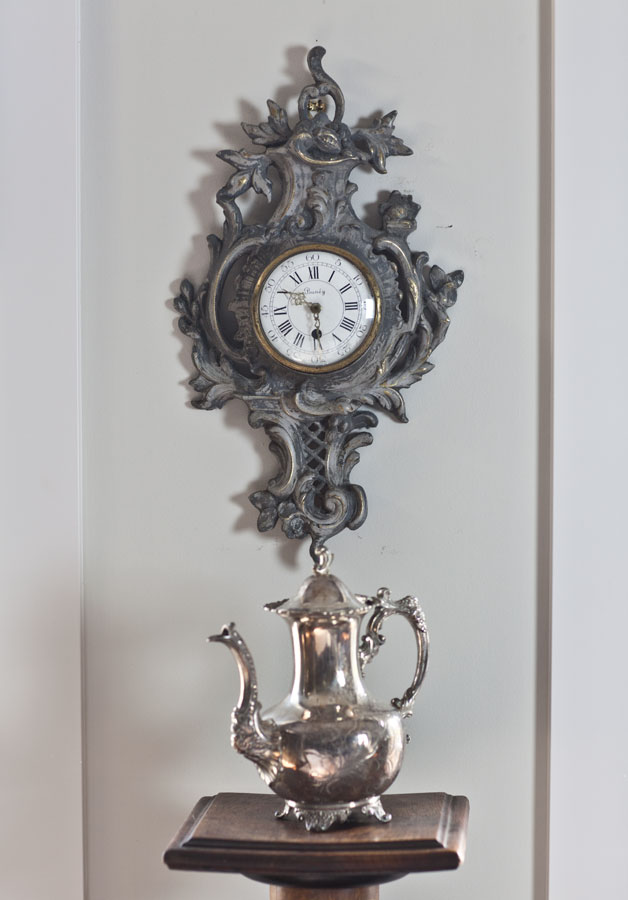
The difference is that it gets dark when it gets wet, and if you get water on it and you don’t have a really good coat of wax protecting it, the paint can come off. I know my friend put a damp sweater on a chair to let it dry. She was shocked when she picked up her sweater later, and saw that much of the paint on her chair got on her sweater. That’s milk paint for you. You have to be careful.
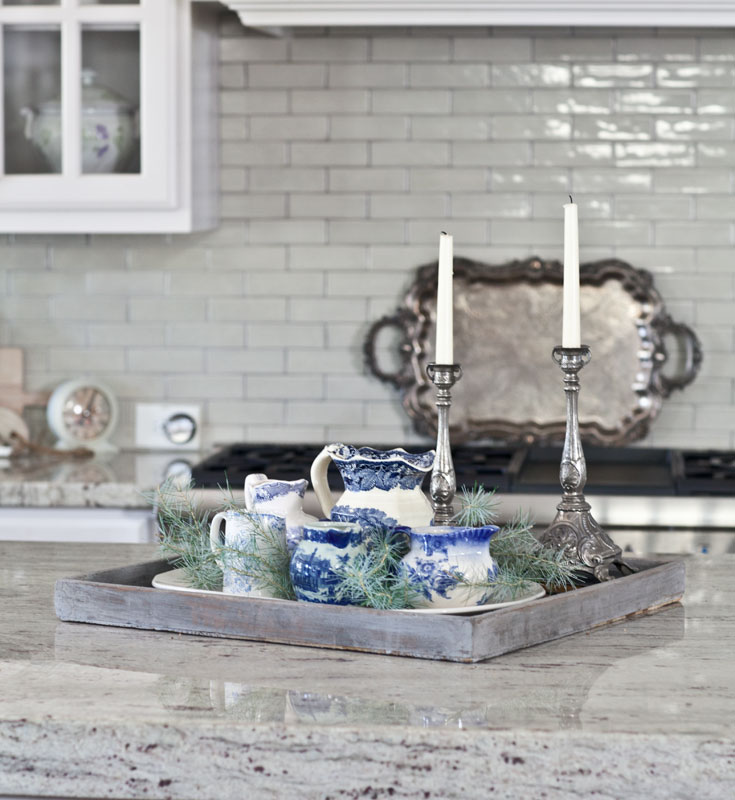
If your item is going to get wet or damp, I highly recommend that you NOT use milk paint. But if you want a very realistic distressed look, and the piece won’t be getting wet, try milk paint. See how the finish is translucent above? That’s milk paint. I used milk paint on the church pew below also.
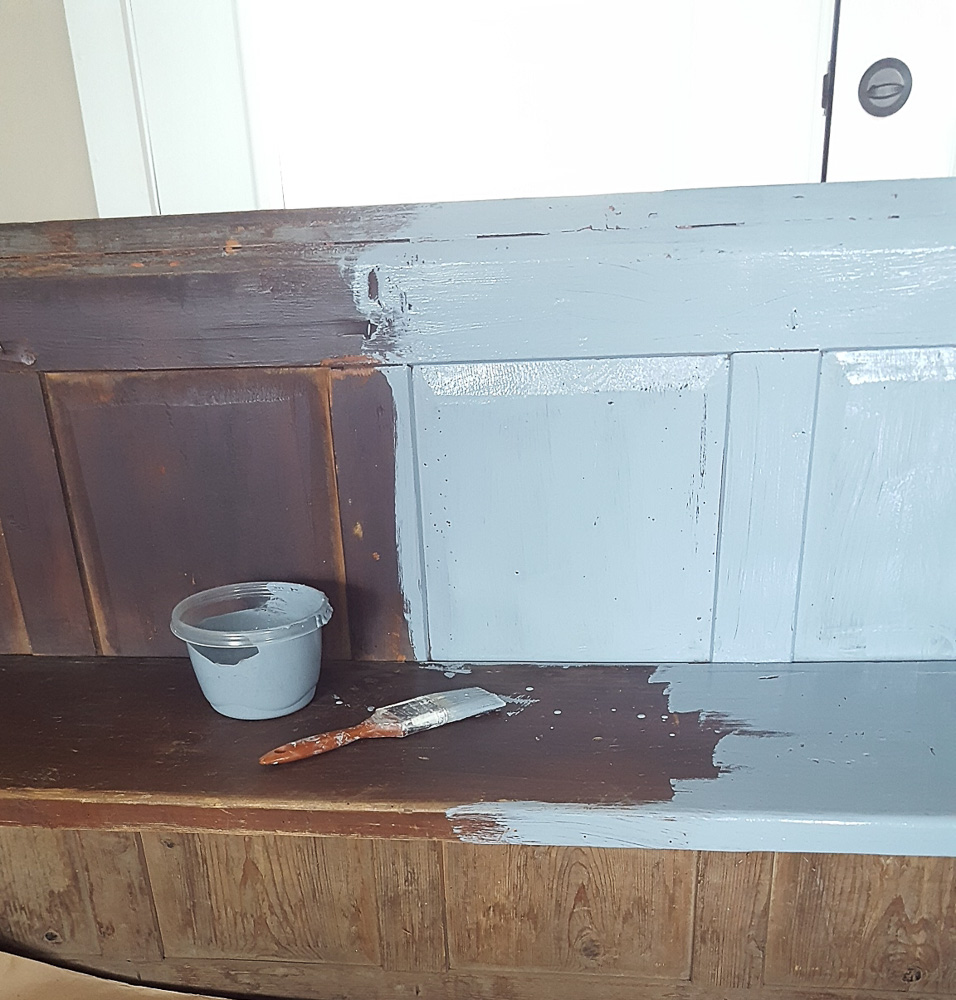
I’m thinking of putting it on the back porch again, but I’m concerned about the rain blowing in. I did coat it with wax, so we’ll see.
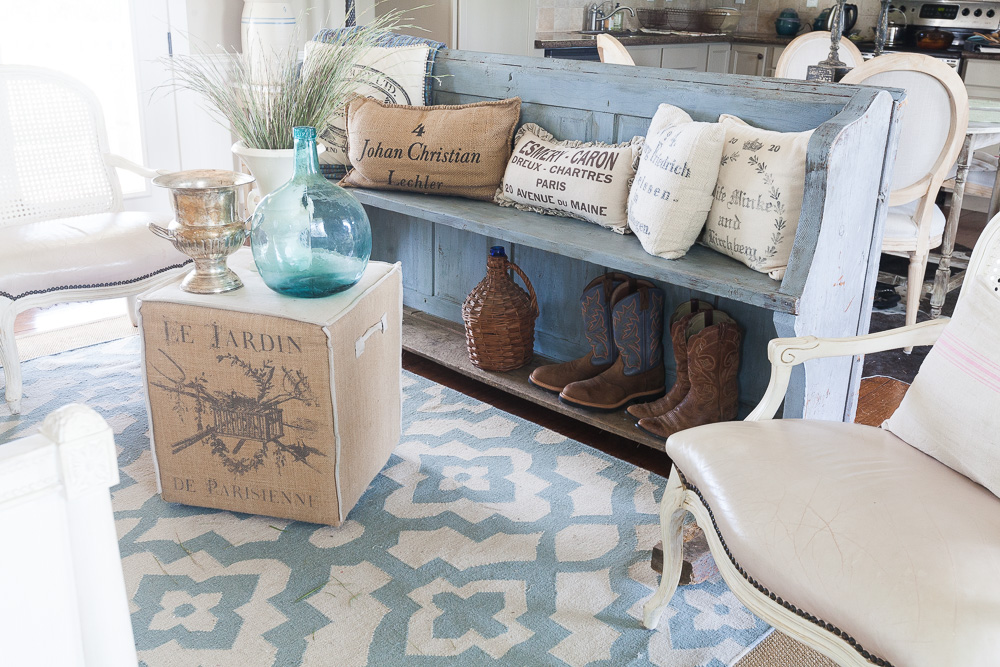
When you are painting with milk paint, the paint dries much lighter than the color when the paint is wet. See the wet paint below?
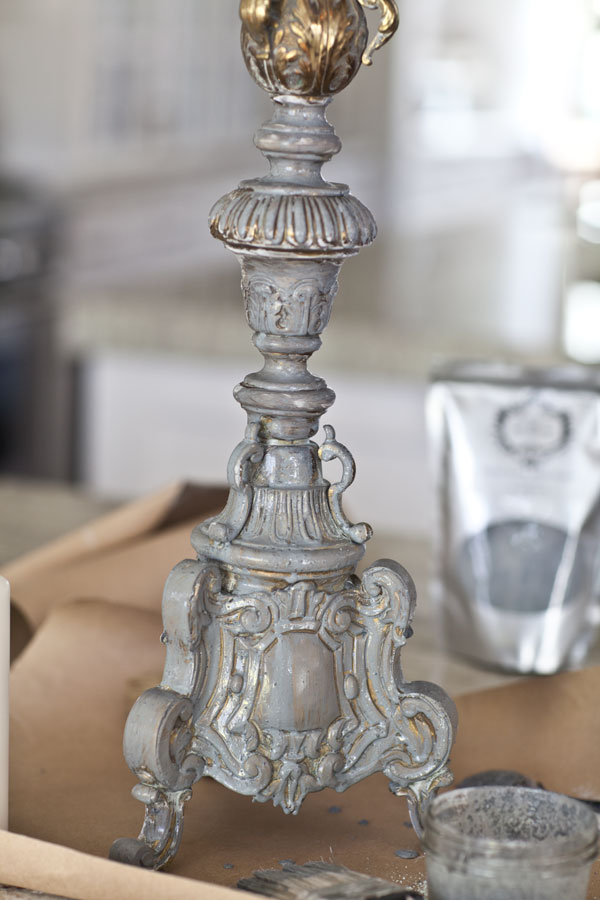
Now check out how much lighter the paint dried.
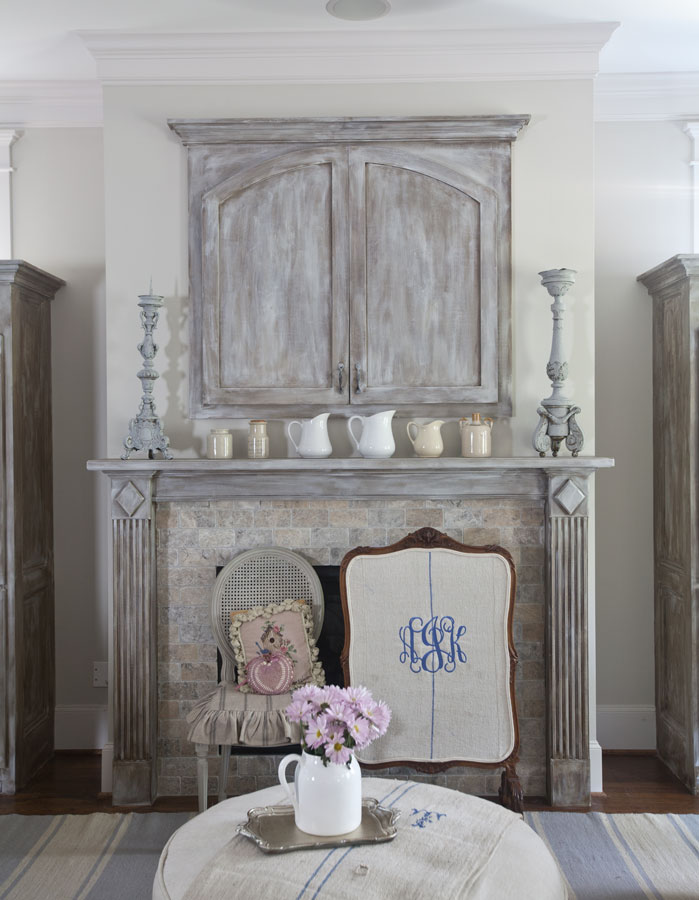
You know the drill. Leave a comment to be entered to win my contest. Details here.

Here is another example of a piece that I painted with milk paint. As I distressed it, much of the paint was removed. The original stain is showing through.

This ottoman is another example of milk paint. I topped it with clear wax and liming wax, which is white.
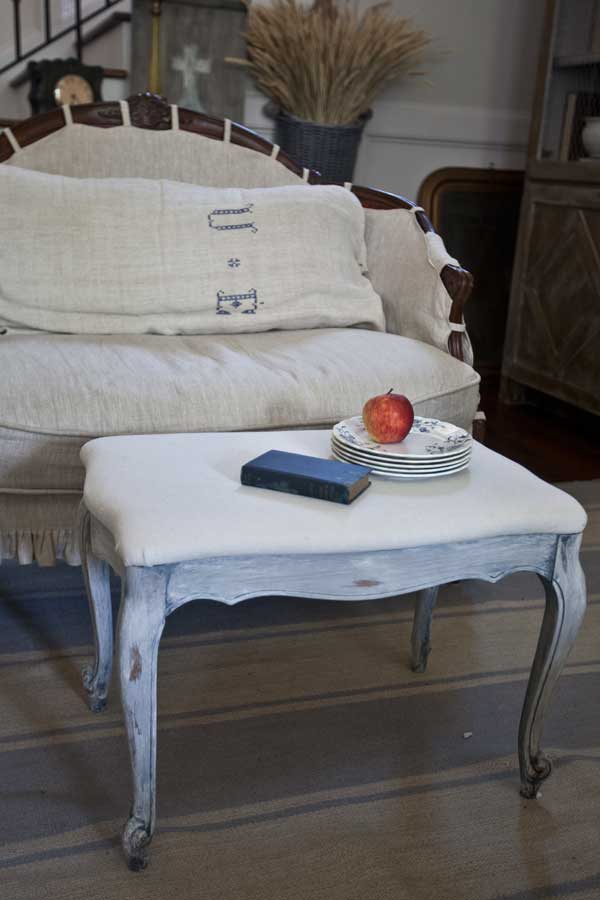
Now let’s talk about chalk based paint.
Chalk based paint comes in a can like regular latex paint. Here is an example.
[shopify embed_type=”product” shop=”cedarhillfarmhouse.myshopify.com” product_handle=”amy-howard-at-home-one-step-paint-luxe-gray-32-ounces” show=”all”]
It goes on much thicker and dries in a thicker coat. Just like milk paint, it can be distressed, but required some elbow grease to sand it. Both chalk based paint and milk paint have a very flat appearance, unless you add a coat of wax. The paint is harder to remove, which is the good news and the bad news. It’s bad news when you are trying to distress something, but good news in that it is going to hold up better to wear.
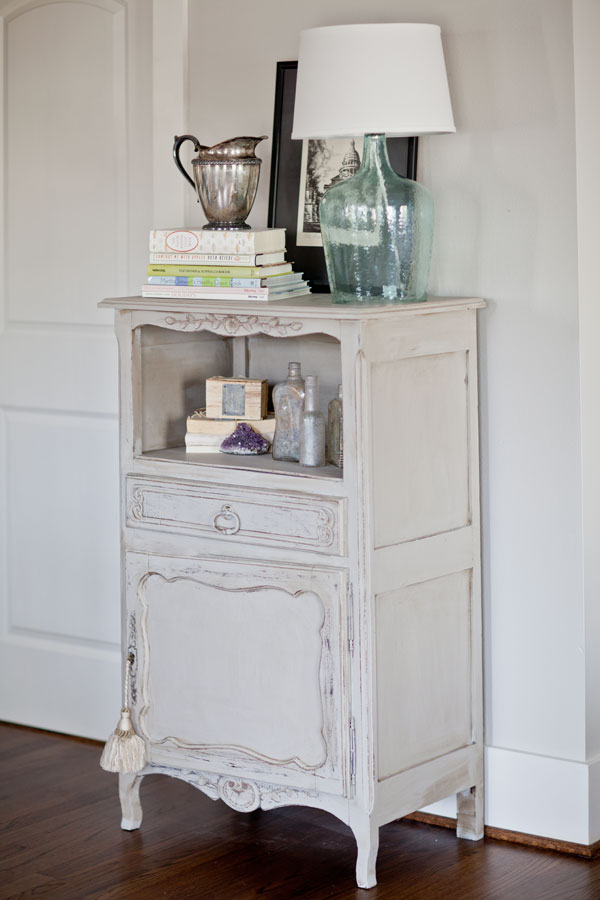
Both paints should be topped with a layer of wax. Both can be used with antiquing glazes and antiquing waxes.
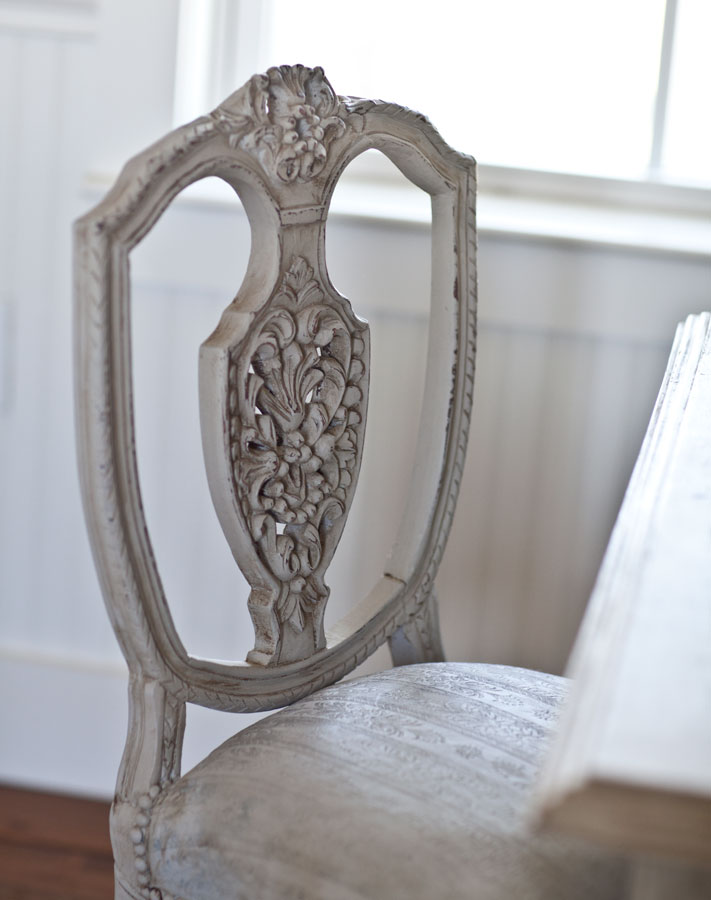
Both are great for a distressed look.
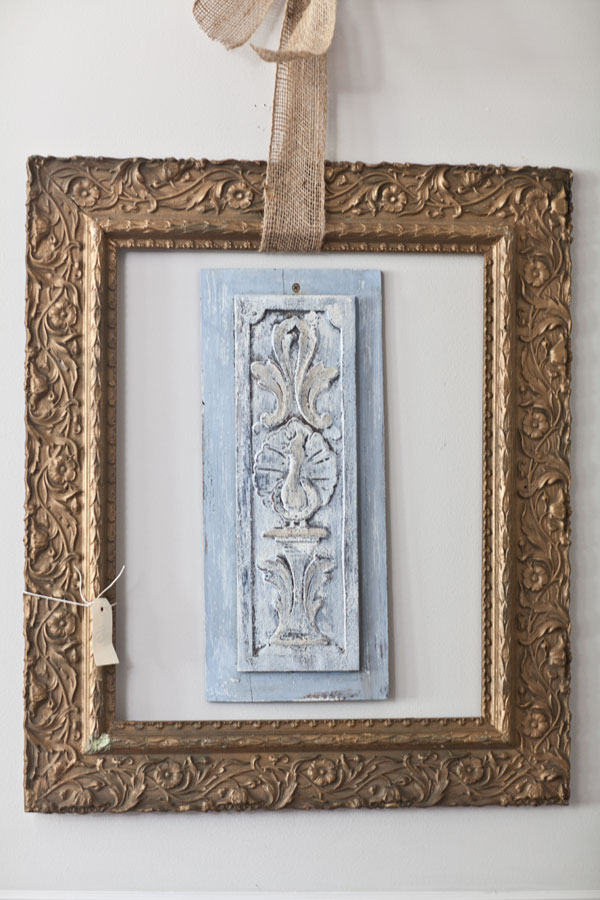
So when do I use milk paint and when do I use chalk-based paint?
I use milk paint when…
- the piece won’t be exposed to water or damp
- I want a lot of distressing
- the item is not going to get a lot of heavy wear
- I want a very subtle antique look
I use chalk-based paint when
- I am not going to do a lot of distressing
- the piece might be exposed to a bit of moisture
- the piece is going to have heavy wear and tear
So chair seats or backs I probably would not do in milk paint. Kitchen cabinets I would not do in milk paint.
Otherwise it is mainly preference.
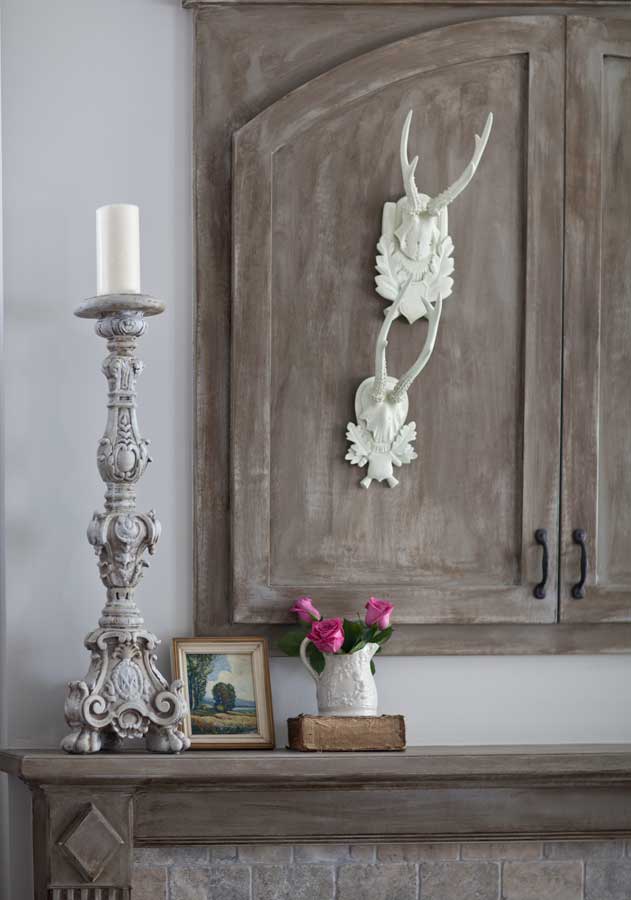
Which one is best for you? I honestly think you need to try both. See how they are different for yourself. You may prefer one over the other.
Below is an example of chalk-based paint. You can see that the distressing is much more obvious.

I’ve got tutorials on using chalk-based paint HERE.
And I have tutorials on using milk paints HERE.
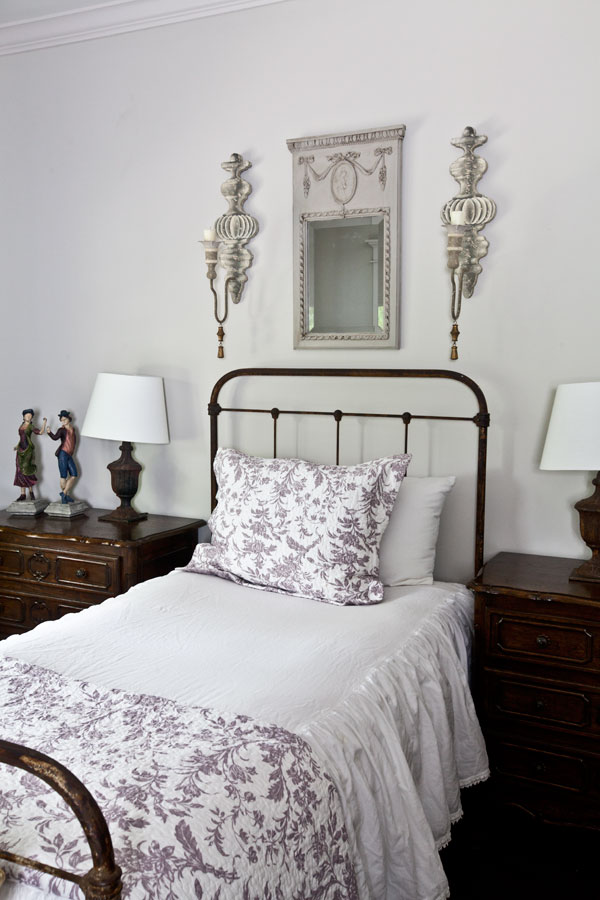
My preference as far as looks go is milk paint, but again, it isn’t always the best choice based on other factors.
Have you used either of the paints? I would love to hear your thoughts. Which do you prefer?
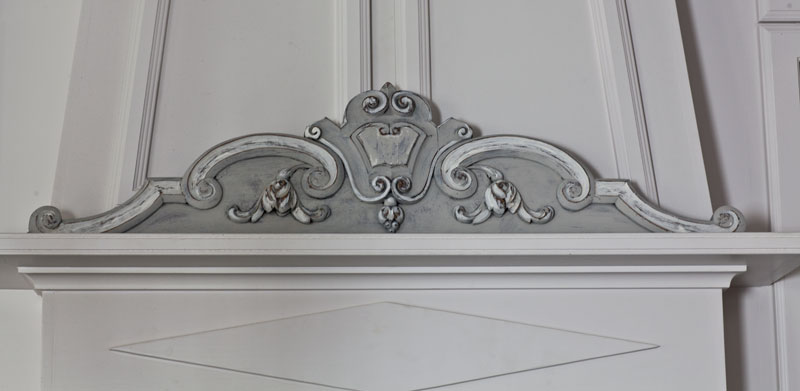
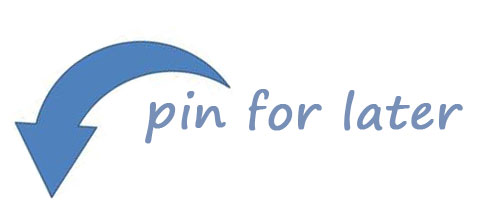
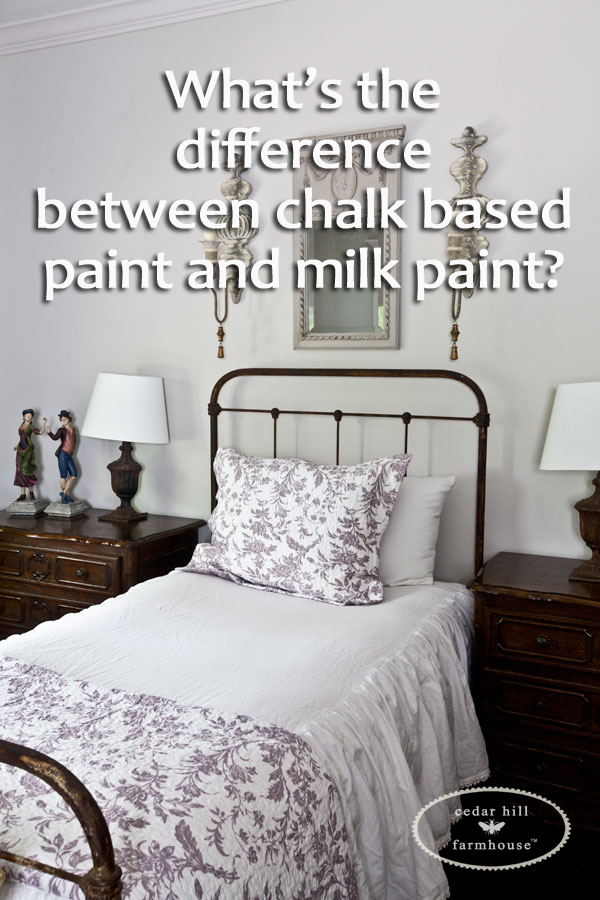
HI Anita. My preference is chalk paint. I, too, have used both but find chalk paint much easier to use. Having recently painted in milk paint a farmhouse-style tv console and coffee table that my husband built, I found that mixing up the paint in small batches at a time so as not to waste it (since once mixed it doesn’t store for very long), was annoying. Also, in spite of the fact that I bought the little mixer tool the paint still ended up always having those little grains in it that I had to keep remixing. I do love it’s colors and used Farmhouse White, but since I don’t particularly love the overly distressed look anyway, I prefer the chalk paint. I have used it on many different things. Like you, we have a vacation place in Western NC and furnished it almost completely with flea market stuff refinished with Annie Sloan Chalk Paint ( I have not yet tried other brands), on everything from lampshades to wood pieces. I will try milk paint on a few more pieces and will hopefully get better with it, but chalk paint requires no practice and even my first piece came out great. I think I will take your lead and try a small piece using chalk paint as a base and milk paint as the top coat. I love to experiment. As an aside, I enjoy reading your blog, and am especially looking forward to more posts about your home in Black Mountain. We have been there often. Great shops! Sue
I totally agree… I love Chalk paint, along with the hard surface and the beautiful satin finish you get. 😉
Thanks for posting this along with all the examples. VERY helpful!
I’ve used chalk paint on several projects and been very happy with it.
I wonder why you didn’t mention Annie Sloan Chalk Paint? I ask because although the word CHALK is in the name, the paint actually doesn’t contain any chalk. So it is is a category by itself. ASCP hardens. And cures after 30 days and if you do NOT wax it the piece can be set outdoors. It distresses beautifully with water, dry brown bag, sand paper, etc. Really it should be tried
Chalk paint never has chalk in it. It is refereed to as chalk paint because of the (chalk) finish of the paint.
Chalk based paint has calcium carbonate in it. Chalk is made from calcium carbonate.
I prefer chalk paint for its durability and ease of use. Milk paint must be prepared and an additive used to control the chipping. I have found that constant stirring is required when using milk paint. They both look great but for versatility and easy application I usually prefer chalk paint. Great article. You explained the differences so well.
This is by far the best article on the differences between both paints & the unique advantages of each one! I don’t generally hold to the black or white philosophy & usually look for compromises. So let’s look at painting a nightstand, desk, coffee table, or dining table. Could you use chalk paint on the base & for durability apply a contrasting or darker shade of the base coat in milk paint on top?
Thanks for explaining the differences.
Have a happy Thanksgiving.
Do you have a tutorial for the chalk paint/milk paint clock? I want to do that to my kitchen island. Great post!
Thanks for your explanation…I’ve made my chalk paint with plaster of Paris…great to get colors you want from your own paint.
I’ve used chalk paint but not milk paint. After seeing this post, I’m going to give it a try! Thanks!
thanks for such an informative and concise post. i found your thoughts most helpful as well as the comments from other readers. how kind of everyone to share. oh, if only women ruled the world….
Thanks for explaining. I’ve used chalk paint but not milk paint. I like the more natural distressed look, so definitely will try the milk paint.
I have used chalk paint but had a difficult time as I was painting a large pine piece and had to deal with some bleed through. I might try the milk paint on something small.
Thank you for the informative and straightforward article. I’ve not used either, so this is a great reference if I choose to use either in future projects. Thank you!
Great info! Thanks for sharing. I’ve never thought about milk paint and what can happen if it gets wet. Something important to consider for sure.
I love milk paint! I think it’s totally worth the trouble of mixing it! It will also work like a stain on new wood. Saying that, I agree if it’s a chair I use chalk paint for durability. Great blog!
I have used Annie Sloan Chalk paint with good results. Have not tried milk paint. I think I just like the idea of paint in a can ready to go! Sometimes I am to anxious to get started – see the color on a piece. I have also mixed up my own version of chalk paint and had no problems with that. But then I have painted things for years – latex, artist paints, stencil paints. Once the entire house was stenciled – just the inside. Kids were afraid I would stencil them! But I did get tired of that look. We are more neutral and calmer now.
I have loved Annie Sloan Chalk paint and the different effects with the clear, dark, and white waxes. The paint is much more forgiving of brush strokes in my experience than regular paints and I have loved the pieces I’ve done (large chest of drawers, shelf, chair, small jewelry box).
Anita, I agree the two paints are quite different as I have used both. I am a dealer for milk paint and have sold many pieces of furniture and signs I painted over the years. There really isn’t any comparison in ease of use. Chalk paint wins hands down but milk paint can make a new piece appear hundreds of years old using the right techniques, I think more authentically over chalk paint. . I do want to clarify that milk paint is durable in wet, even winter climates with an acrylic or poly finish. I have left signs hanging unprotected throughout the 4 seasons, including winters in Maine. When I open my new shop in the spring of 2017, I will be using chalk and milk paints. I love them both. Thank you for addressing both paints!
Anita, I agree the two paints are quite different as I have used both. I am a dealer for milk paint and have sold many pieces of furniture and signs I painted over the years. There really isn’t any comparison in ease of use. Chalk paint wins hands down but milk paint can make a new piece appear hundreds of years old using the right techniques, I think more authentically over chalk paint. . I do want to clarify that milk paint is durable in wet, even winter climates with an acrylic or poly finish. I have left signs hanging unprotected throughout the 4 seasons, including winters in Maine. When I open my new shop in the spring of 2017, I will be using chalk and milk paints. I love them both. Thank you for addressing both paints!
What a huge help! Great tips!!
I have tried milk, chalk, and finally fusion mineral paint. Milk and chalk paint are both fine, but I find the mineral paint to be superior to both. The coverage is great (used 2 coats with a very light sheen. I used wax to protect the shelves altho not necessary. I will be purchasing otheer colors in the mineral paint.
Where can I get a white bedspread like the one in the last picture?
This is actually a bed skirt Faye.
Thanks for the information.
Great explanations, Anita! I have only used chalk paint and have wondered if I should try milk paint. I think I will, now that I have a useful guide on when to use it. Have a very Happy Thanksgiving!!
I love chalk paint. I have painted several tables with it and they turned out great. I have not used milk paint but I will try it on my next project.
Thanks for the detailed explanation of both paints. I’ve only used chalk paint and love it.
I use Annie Sloan Chalk paint, so easy to use! I mainly use Old White and then either wax with clear or dark wax and buff it right back to bring out the details of a piece.
I have mixed my own with plaster of paris and water but prefer the ease of just buying a can.
I have never used milk paint and did not know it required waxing to become impervious to moisture. I have used Annie Sloan paints and distressed both with sandpaper (after dry) and damp rags shortly after painting (eliminates sanding dust). I do plan on trying milk paint after seeing your tray, candlesticks, etc. I like the translucent qualities I see there after you have distressed/wiped. Thanks for expanding my interest!
Thanks for the education! I have only used chalk paint and it is great to know what the differences are.
Great blog and reader’s comments!
I have just purchased my first can of chalk paint, so am grateful for all your tips thank you.
Regarding milk paint: I live in south Florida. Can the milk paint get moldy in the humidity? Can it attract insects?
Thanks!
I have always liked the look of chalk paint, but your excellent examples have shown me that I really prefer it. Thanks for the talk.
Very helpful post. I had assumed the two were interchangeable — thanks for setting me straight!
I’ve only used chalk paint and I’ve been pretty happy with the results. I have some coasters that are well made. I bought them at my local thrift store for a great price. I didn’t like the image on them at all, so last week I gave them a coat of black chalk paint. Because I want to write on them with white chalk, I didn’t give them a coat of wax. I drew a circle around the edge (they’re round) and wrote a Thanksgiving-themed word in the center of each one. I love the results and they’ve held up well so far.
Thanks for the detailed information on milk paint. I was not too familiar with it and appreciate all the details.
This article came at the perfect time as I have a bunch of candle sticks to paint and have been wondering what paint type and color to choose. I have never tried milk paint before but plan on it now for sure.
So informative! Also the one you wrote about waxes. I have outdated golden oak cabinets and am considering using liming wax on them. My friend used SW industrial paint on kitchen cabinets and swears she didn’t sand.
Informative article on milk and chalk paints. Thanks, Anita
Thank you for clarifying the differences. Having used both, I must say that I totally prefer ASCP because of the look, ease of use and because it can be used on anything.
My understanding from ASCP in England that ASCP Wall Paint might be available in the states in 2017! Limited colors, mostly neutrals – but how I yearn to be able to have wall paint (applied with a roller) that will match cupboards, etc. Can’t wait for this product to be available here on this side of the pond.
Again, thank you for the info and the great pictures!
Thanks for the tips! Happy thanksgiving
I’ve been curious about milk paint and you give a great description of it and how it differs from chalk paint. Thank you.
Thanks for a very informative explanation. I have yet to attempt a painting project using chalk paint — you keep inspiring me to try.
Thanks for the informative article and the accompanying pictures. I love the cute little bedroom. The design and colors are lovely.
Consider using General Finishes Milk Paint. It is heaven to use. I exclusively use Annie Sloan Chalk paint and General Finishes Milk paint in my furniture paint business.
Which one i use for a project depends on the style of the piece, the finish I want and the color I want the piece of furniture to be.
General Finishes is much less expensive than ASCP with as good of results.
DIB, I foudn your comment interspersing. and have made a note on General Finishes and Annie Sloan brands. Thank you.
Well you helped me make the choice and that, for me anyway, is to use the safer bet with Chalk based pant, as most things carry a little potential for being exposed to some moisture.. A little more work but worth it.
A college friend and I of many years have started a little rustic décor business and find your blog inspirational in country French décor.
Thank you,
G-d bless,
So timely! I was just getting ready to paint a secretaries desk, but couldn’t decide which paint to use. Your article helped me a lot and the great info for future projects. Thank you Anita.